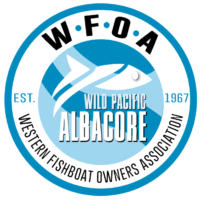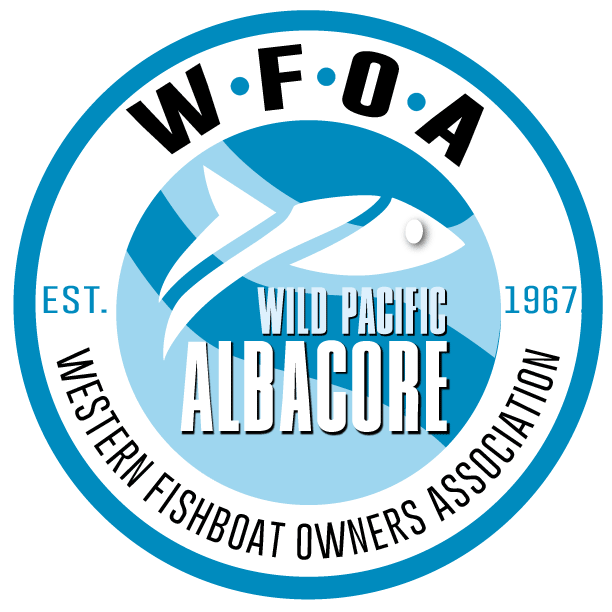NUTRITION/HEALTH INFORMATION
Albacore tuna is the only tuna that can be canned under the “white meat” label. Its range is worldwide in temperate waters between 12ºC and 19ºC. The U.S. troll/pole fleet catch albacore in the colder waters that have higher Omega-3 oil content than the albacore caught by foreign longline fleets in the more tropical waters.

Because albacore is so far-ranging, worldwide production is around 250,000 metric tons per year. This species is an important food source that’s high in protein and is consumed in many ways besides traditional canning methods. The U.S. troll fleet catches about 14,000 metric tons per year for comparison.

Albacore caught by longline methods that are 5-7 years old and canned by major canners can be distinguished on the label as having 1g of fat per serving, while troll/pole and line caught albacore that is 3-5 years old is labeled at 4g of fat or higher. (NOTE: It is ironic that people purchase the lower-fat tuna and then take it home and add numerous grams of fat with the addition of mayonnaise.)
The two images below are labels from the same brand of tuna — but the first one is longline-caught and the second is troll-caught albacore. Note the Total Fat (Grams), 1.0g as opposed to 5.0g. Though slightly higher in fat, the troll-caught albacore is much higher in Omega-3’s.
Longline albacore
Troll-caught albacore
GENERAL SEAFOOD AND HEALTH LINKS
The following publications and sites are good sources of reference for food security and supply worldwide:
- NOAA Fishwatch -U.S. Seafood Facts
- The Danger of Not Eating Tuna – Article
- Omega-3 Centre
- Seafood Network Information Center
MERCURY IN ALBACORE: The Good News and Bad News about Mercury and Consumption.
The Good News and Bad News about Mercury and Consumption.
The FDA of the U.S. is proposing changes to fish consumption guidelines especially regarding women who are pregnant. They will begin encouraging fish consumption of at least 8 -12 oz per week of seafood in general, to increase the intake of protein, omega 3 fatty acids, and nutrients found in seafood products. This is good news as many get scared off by sensationalist stories in the media and do not eat seafood. By avoiding seafood consumers may unfortunately replace it with fewer nutritious choices with no reliable information on the subject. Unfortunately the guidelines given on albacore tuna recommending 6 oz and less per week are skewed and do not take into consideration of the nature of the fishery especially here on the west coast where albacore caught are younger then the predominately canned albacore which is higher in mercury. U.S. west coast albacore is very low in testing done over the past 10 years. The Canadian government has recognized that fact in their recommendations.
The fact is that albacore is generally caught in two methods worldwide. Longlining for albacore occurs in the more tropical water and probably accounts for about 70% of the worldwide catch. Troll/Pole and Line accounts for the remainder and occurs in the subtropical zones of the U.S. west coast, Japan, New Zealand, South Africa, and the Bay of Biscay in Europe. Foreign longline caught albacore targets the larger 5-7 year-old fish and almost all of this is canned by major canners overseas and a large percentage is consumed in the U.S. under major brand names. It is generally labeled as 1 gram of fat or less. Troll/Pole and Line fisheries catch 3-5 year-old albacore which is higher in fat and omega-3’s and if you find it in a can the fat content will be generally 4 grams or more.
Longline caught albacore has tested higher in mercury but still far below FDA standards. Given it is the major consumer marketed albacore in the U.S. longline caught albacore is not separated from troll/pole which the mercury levels are far below the larger fish in retail stores, nor by the FDA, or in media stories. This leaves the U.S. hook and line fishermen on the west coast fishing a very healthful tuna in a very sustainable method, in a situation of being lumped in with higher mercury albacore. Also, studies have also been conducted over the past eight years by the University of North Dakota – Dr. Nick Ralston showing the presence of selenium in fish such as albacore tuna mitigate any harmful effects of mercury.
Therefore, we are pleased with FDA’s attempt to encourage more seafood consumption but they also need to know that one size has never fit all when it comes to albacore. The Monterey Bay Aquarium has made this distinction in its Green, Yellow, Red lists and it is time for the FDA to recognize a 30,000,000 pound annual fishery the US has and its health benefits.
To find local albacore visit: Wild Pacific Albacore
Wayne Heikkila
WFOA
More articles and information on mercury:
- Seafood benefits outweigh risks, government says
- Review of Previous Studies Indicates Health Benefits From Eating Fish Outweigh Risks
- SCIENTISTS WANT US TO BE HOOKED ON FISH
- Oregon State University Mercury Test Results
- Mercury Results Poster
- WFOA Letter to FDA
- Harvard School of Public Health Study
- San Francisco Chronicle: Trolling for a Market Niche
SELENIUM AS A MITIGATING FACTOR: The reason that high doses of methylmercury can cause harm in the body appears to be because mercury interferes with normal metabolic activities of selenium, an essential dietary nutrient. Supplementation with additional selenium has long been known to protect the body from adverse effects of mercury exposure. It now appears that this occurs because the additional selenium replaces the selenium that becomes unusable because of mercury binding. In addition, the considerable selenium content in albacore is beneficial; selenium binds to mercury, decreasing or eliminating its negative effects on the system.
- Seleniums Role in Seafood Safety
- Dr. Nick Ralston & Dr. Laurie Raymond / Selenium in Seafood
- Lancet Paper on Selenium/Mercury
- Selenium in Seafood Flyer 2008
DOWNLOADABLE FILES BY DR. JOYCE NETTLETON ON ALBACORE:
- Press Release
- New Tuna in Town
- Health Benefits
- Cardio Health
- Maternal Infant Health
- Clinical Conditions
Please Check Back for Updates on These Issues:




